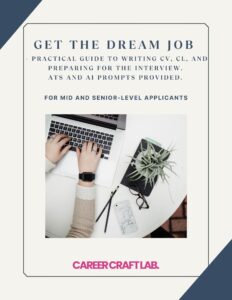ATS-friendly CV is killing our individualism…. In today’s digital job market, your first impression is often not seen by a human—but by a machine.
Applicant Tracking Systems (ATS) have become the gatekeepers of modern recruitment. These systems scan CVs for keywords, formats, and experience matches before a recruiter even lays eyes on your application. The result? A surge in templates, keyword stuffing, and formulaic CVs crafted to “beat the bot.”
But here’s the uncomfortable question:
👉 Is optimizing your CV for an algorithm limiting your authenticity, creativity, and innovation?
🧠 What Is an ATS-Friendly CV?
An ATS-friendly CV is designed to be easily parsed by software. It typically follows these rules:
-
- Uses standard section headings (e.g., “Experience,” “Skills,” “Education”)
-
- Avoids graphics, images, columns, or unusual fonts
-
- Includes industry-specific keywords
-
- Sticks to reverse chronological format
-
- Limits creativity to ensure compatibility
These are practical guidelines—no doubt. But in making our resumes machine-readable, many job seekers feel forced to strip away personality, storytelling, and original design.
💡 The Creativity Dilemma
The problem? Innovation and originality rarely live inside a template.
-
- Designers can’t showcase creativity in a grayscale Word doc
-
- Marketers lose their storytelling magic
-
- Entrepreneurs seem too “non-linear” to fit chronological molds
-
- Career switchers can’t fully explain transferable skills through keyword snippets alone
We’ve traded compelling personal narratives for robotic uniformity—and in some industries, that’s a real loss
🤖 Why We Still Need ATS Optimization For Now)
ATS systems aren’t going away. For companies receiving hundreds of applications per role, automation is necessary. And if your CV never makes it through the filter, originality won’t matter—it won’t be seen.
So yes, an ATS-friendly resume is important. But it doesn’t have to kill your creativity.
🧩 The Balance: How to Stay Original and Be ATS-Friendly
Here’s how you can preserve your voice, innovation, and originality while still playing by the ATS rules:
1. Tell Your Story in the Cover Letter or LinkedIn Profile
Use the CV to get through the gate. Use your cover letter to express personality, leadership stories, or creative achievements.
2. Use Powerful Language, Not Just Keywords
Yes, match keywords—but avoid being robotic. Use action verbs and results-driven phrases that still sound like you.
3. Add a Personal Brand Statement
A brief, bold summary at the top can highlight your unique value—while staying ATS-compliant.
4. Include a Link to a Personal Website or Portfolio
Showcase innovation and personality outside the CV. Creative professionals can direct recruiters to a beautifully designed page that proves their skills.
5. Tailor Without Losing Authenticity
Customizing each resume doesn’t mean changing who you are. It means aligning your truth to the role’s language.
The Bottom Line
The rise of ATS technology has certainly changed how we write resumes—but it doesn’t have to kill originality.
Instead of asking “ATS or authenticity?” the real question is:
How do I design a strategy that gets me noticed and remembered?
A great career isn’t built by beating bots—it’s built by connecting with people. Let the bots scan your CV, but let your voice lead the way.
Need help creating a CV that gets through the system and stands out?
Check out our free “Get the Dream Job” Guide—with CV prompts, interview tips, and ChatGPT-powered career tools to help you shine or review our coaching packages.



